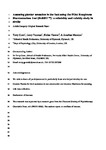Assessing plantar sensation in the foot using the FOot Roughness Discrimination Test (FoRDT™): a reliability and validity study in stroke.
| dc.contributor.author | Gorst, T | |
| dc.contributor.author | Freeman, Jennifer | |
| dc.contributor.author | Yarrow, K | |
| dc.contributor.author | Marsden, Jonathan | |
| dc.date.accessioned | 2019-02-26T10:03:21Z | |
| dc.date.issued | 2019-01-28 | |
| dc.identifier.issn | 1934-1482 | |
| dc.identifier.issn | 1934-1563 | |
| dc.identifier.uri | http://hdl.handle.net/10026.1/13353 | |
| dc.description | Publisher’s embargo period: Embargo set on 01.03.2019 by SR (TIS). | |
| dc.description.abstract |
BACKGROUND: The foot sole represents a sensory dynamometric map and is essential for balance and gait control. Sensory impairments are common, yet often difficult to quantify in neurological conditions, particularly stroke. A functionally oriented and quantifiable assessment, the Foot Roughness Discrimination Test (FoRDT™), was developed to address these shortcomings. OBJECTIVE: To evaluate inter- and intra-rater reliability, convergent and discriminant validity of the Foot Roughness Discrimination Test (FoRDT™). DESIGN: Test-retest design. SETTING: Hospital Outpatient. PARTICIPANTS: Thirty-two people with stroke (mean age 70) at least 3 months after stroke, and 32 healthy, age-matched controls (mean age 70). MAIN OUTCOME MEASURES: Roughness discrimination thresholds were quantified utilising acrylic foot plates, laser-cut to produce graded spatial gratings. Stroke participants were tested on three occasions, and by two different raters. Inter- and intra-rater reliability and agreement were evaluated with Intraclass Correlation Coefficients and Bland-Altman plots. Convergent validity was evaluated through Spearman rank correlation coefficients (rho) between the FoRDT™ and the Erasmus modified Nottingham Sensory Assessment (EmNSA). RESULTS: Intra- and inter rater reliability and agreement were excellent (ICC =.86 (95% CI .72-.92) and .90 (95% CI .76 -.96)). Discriminant validity was demonstrated through significant differences in FoRDT™ between stroke and control participants (p< .001). Stroke fallers had statistically significant higher FoRDT™ scores compared to non-fallers (p=.01). Convergent validity was demonstrated through significant and strong correlations (rho) with the Erasmus MC Nottingham Sensory Assessment (r=.69, p<.01). Receiver Operator Curve analysis indicated the novel test to have excellent sensitivity and specificity in predicting the presence of self- reported sensory impairments. Functional Reach test significantly correlated with FoRDT™ (r=.62, p< .01) whilst measures of postural sway and gait speed did not (r=.16-.26, p>.05). CONCLUSIONS: This simple and functionally oriented test of plantar sensation is reliable, valid and clinically feasible for use in an ambulatory, chronic stroke and elderly population. It offers clinicians and researchers a sensitive and robust sensory measure and may further support the evaluation of rehabilitation targeting foot sensation. This article is protected by copyright. All rights reserved. | |
| dc.format.extent | 1083-1092 | |
| dc.format.medium | Print-Electronic | |
| dc.language | en | |
| dc.language.iso | en | |
| dc.publisher | Elsevier | |
| dc.subject | Aged | |
| dc.subject | Case-Control Studies | |
| dc.subject | Female | |
| dc.subject | Foot | |
| dc.subject | Humans | |
| dc.subject | Male | |
| dc.subject | Neurologic Examination | |
| dc.subject | Psychometrics | |
| dc.subject | Reproducibility of Results | |
| dc.subject | Sampling Studies | |
| dc.subject | Sensation Disorders | |
| dc.subject | Stroke | |
| dc.subject | Touch | |
| dc.title | Assessing plantar sensation in the foot using the FOot Roughness Discrimination Test (FoRDT™): a reliability and validity study in stroke. | |
| dc.type | journal-article | |
| dc.type | Journal Article | |
| dc.type | Research Support, Non-U.S. Gov't | |
| dc.type | Validation Study | |
| plymouth.author-url | https://www.ncbi.nlm.nih.gov/pubmed/30690894 | |
| plymouth.issue | 10 | |
| plymouth.volume | 11 | |
| plymouth.publication-status | Published | |
| plymouth.journal | PM&R | |
| dc.identifier.doi | 10.1002/pmrj.12085 | |
| plymouth.organisational-group | /Plymouth | |
| plymouth.organisational-group | /Plymouth/Faculty of Health | |
| plymouth.organisational-group | /Plymouth/Faculty of Health/School of Health Professions | |
| plymouth.organisational-group | /Plymouth/REF 2021 Researchers by UoA | |
| plymouth.organisational-group | /Plymouth/REF 2021 Researchers by UoA/UoA03 Allied Health Professions, Dentistry, Nursing and Pharmacy | |
| plymouth.organisational-group | /Plymouth/Research Groups | |
| plymouth.organisational-group | /Plymouth/Research Groups/FoH - Applied Parkinson's Research | |
| plymouth.organisational-group | /Plymouth/Research Groups/Institute of Health and Community | |
| plymouth.organisational-group | /Plymouth/Research Groups/Plymouth Institute of Health and Care Research (PIHR) | |
| plymouth.organisational-group | /Plymouth/Users by role | |
| plymouth.organisational-group | /Plymouth/Users by role/Academics | |
| plymouth.organisational-group | /Plymouth/Users by role/Researchers in ResearchFish submission | |
| dc.publisher.place | United States | |
| dcterms.dateAccepted | 2018-12-11 | |
| dc.rights.embargodate | 2020-1-28 | |
| dc.identifier.eissn | 1934-1563 | |
| dc.rights.embargoperiod | Not known | |
| rioxxterms.versionofrecord | 10.1002/pmrj.12085 | |
| rioxxterms.licenseref.uri | http://www.rioxx.net/licenses/all-rights-reserved | |
| rioxxterms.licenseref.startdate | 2019-01-28 | |
| rioxxterms.type | Journal Article/Review |


